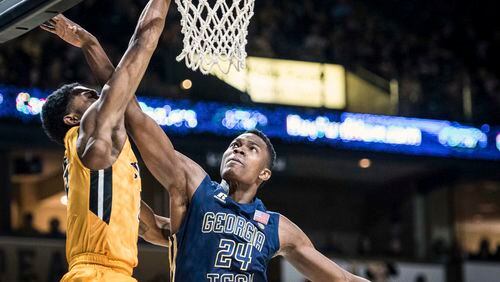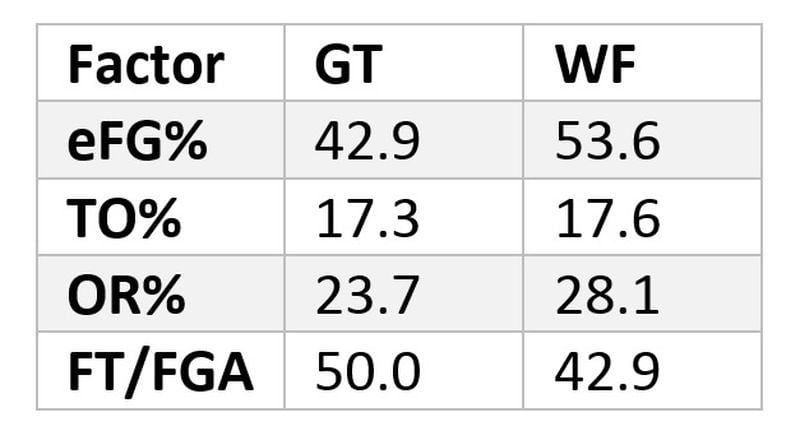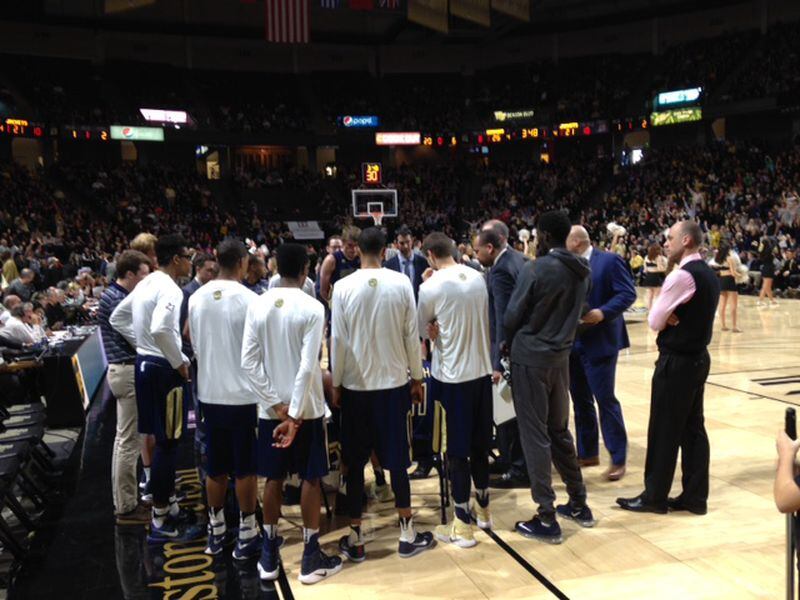A look back at Georgia Tech's 81-69 loss to Wake Forest Saturday in Winston-Salem, N.C. You can read the "5 things" story here .
Four factors*
Credit: Ken Sugiura
Credit: Ken Sugiura
The big difference is in the top line. Wake Forest's 53.6 percent on effective field-goal percentage was the second highest that Tech has permitted after the debacle against Duke. Wake Forest's average coming into the game was 51.9 percent, meaning that what was just a little above average for the Demon Deacons offensively was pretty poor performance for the Yellow Jackets on defense.
Tech has lost in offensive rebounding percentage in eight of its 11 ACC games, which is not surprise in that offensive rebounding just isn't something that the Jackets do well. Forward Quinton Stephens is having a great season on the glass as a power forward, but after him and center Ben Lammers, there isn't a frontcourt player who can go win a lot of offensive rebounds. Think of someone like Charles Mitchell. Offensive rebounding, though, is a marker of energy and effort and, not surprisingly, Tech is 3-0 in the games in which it won that category (Clemson, Florida State and Notre Dame).
*Four factors follows the idea that the four statistics that most lead to success are effective field-goal percentage (which weights 3-point baskets proportionately), turnover percentage, offensive rebounding percentage and free throws per field-goal attempts.
Thought
Tech’s limitations with who was available was a big part of the loss, as Lammers played eight minutes in the first half with foul trouble and 26 altogether and guard Justin Moore didn't play with an abdominal injury, but the Yellow Jackets didn’t play great offense, especially in the first half.
The shot selection was sometimes rushed and there were nine turnovers in 33 possessions. Tech was 8-for-27 in the first half, including 5-for-18 inside the 3-point arc. That is pretty dreadful.
A lot of it had to do with Lammers being out for 12 of the first 20 minutes due to foul trouble, but it wasn’t all of it. Needing to be near perfect against Wake Forest, Tech just wasn’t.
“I felt we massaged too much, trying to play one-on-one basketball, and we’re just not good enough to do that,” Josh Pastner said.
For NCAA tournament hopes, any loss is punitive. A 13-10 record, even with very impressive wins, is a detriment, and this was an opportunity to win a tough and impressive game. Particularly given the circumstances, it would have said a lot, but the Jackets didn't give themselves much of a chance against a team that doesn't defend particularly well.
Stat of the game
Wake Forest was 6-for-13 from 3-point range in the second half. That included makes on the first two possessions of the half, which extended a six-point halftime lead to 12. Tech didn’t go away in the final 20 minutes, despite a lot of reasons to do so, but timely 3-pointers kept the Demon Deacons’ safely ahead.
"We played hard, but we can’t spot them six points starting the second half," forward Quinton Stephens said.
Quote of the game
"We've become a good team. We just are hanging by a thread in many, many areas." - Pastner
Individually speaking
Forward Sylvester Ogbonda, pressed into action when center Ben Lammers got into foul trouble in the first half, did about as well as could be hoped. Ogbonda, who had been in only three of Tech’s 10 ACC games for a total of 14 minutes, equaled that total Saturday for a career high. He was active on the glass (two rebounds and was effective boxing out) and didn’t back down physically, which led to his fouling out so quickly.
He wasn’t ready to play such an integral role in the offense, as the offense ran through him as it does through Lammers when he was on the floor, but he didn’t turn the ball over and even scored on a jump hook and got to the line four times. He finished with five points.
"Sylvester came in and did a nice job for us," Pastner said.
Stephens had his fifth double-double of the season with 14 points and 11 rebounds, the latter a team high. He'd need to do some work, but he and Lammers both are in the neighborhood of becoming the first Tech players to average a double-double since Alvin Jones in 2000-01. Stephens is averaging 10.7 points per game with 8.3 rebounds, while Lammers is at 14.8 and 9.5. For Stephens to finish the regular season with 10 rebounds (not rounding up), he would need to average 14.9 rebounds per game, which might be asking a bit much. For Lammers, he needs to average 11.4.
From my iPhone
Credit: Ken Sugiura
Credit: Ken Sugiura
The vantage point from my seat at the press table. It’s probably my favorite of any arena in the ACC as it’s, as you can tell, right next to the visiting bench. You see and hear a lot that you don’t virtually anywhere else.
On a personal note
On the topic of vantage point, I was granted a pretty good one for the entire trip. I was allowed to be a part of the team’s travel party and was there for the flight, the team meals, a meeting, shootaround and halftime. It was for a story that will run this week. I think, or at least hope, you’ll find it an interesting read.









